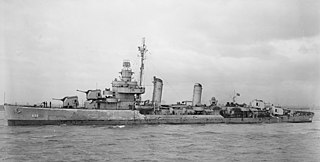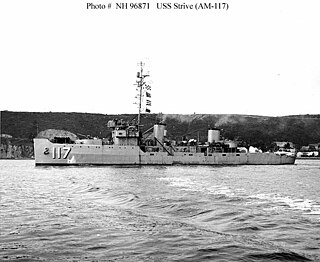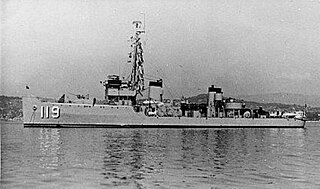
USS Butler (DD-636), a Gleaves-class destroyer, is the only ship of the United States Navy to be named for Marine Corps Major General Smedley Butler, twice awarded the Medal of Honor.

USS Knight (DD-633), a Gleaves-class destroyer, is the only ship of the United States Navy to be named for Admiral Austin M. Knight.

The third USS Trippe (DD-403) was a Benham-class destroyer in the United States Navy. She was named for John Trippe.

USS Cowie (DD-632), a Gleaves-class destroyer, is the only ship of the United States Navy to be named for Rear Admiral Thomas Jefferson Cowie.

USS Jeffers (DD-621/DMS-27), a Gleaves-class destroyer, was the only ship of the United States Navy to be named for Commodore William N. Jeffers.

USS Rhind (DD-404) was a Benham-class destroyer in the United States Navy. She was named for Alexander Colden Rhind.

USS Seer (AM-112/MSF-112/MMC-5) was an Auk-class minesweeper of the United States Navy that served during World War II and the Korean War, and was sold to Norway in 1962.
USS Swift (AM-122) was an Auk-class minesweeper acquired by the United States Navy for the dangerous task of removing mines from minefields laid in the water to prevent ships from passing.
USS Symbol (AM-123) was an Auk-class minesweeper acquired by the United States Navy for the dangerous task of removing mines from minefields laid in the water to prevent ships from passing.
USS Pilot (AM-104) was a United States Navy Auk-class minesweeper that saw service in the Mediterranean and Pacific Theaters of Operations during World War II.

USS Staff (AM-114) was an Auk-class minesweeper acquired by the United States Navy for the dangerous task of removing mines from minefields laid in the water to prevent ships from passing.

USS Strive (AM-117) was an Auk-class minesweeper acquired by the United States Navy for the dangerous task of removing mines from minefields laid in the water to prevent ships from passing.

USS Steady (AM-118) was an Auk-class minesweeper acquired by the United States Navy for the dangerous task of removing mines from minefields laid in the water to prevent ships from passing.

USS Sustain (AM-119) was an Auk-class minesweeper acquired by the United States Navy for the dangerous task of removing mines from minefields laid in the water to prevent ships from passing.
USS Sway (AM-120) was an Auk-class minesweeper acquired by the United States Navy for the dangerous task of removing mines from minefields laid in the water to prevent ships from passing.

USS Threat (AM-124) was an Auk-class minesweeper acquired by the United States Navy for the dangerous task of removing mines from minefields laid in the water to prevent ships from passing.
USS Tumult (AM-127) was an Auk-class minesweeper acquired by the United States Navy for the dangerous task of removing mines from minefields laid in the water to prevent ships from passing.
USS Despite (AM-89) was an Adroit-class minesweeper of the United States Navy. Laid down on 24 November 1941 by the Dravo Corporation, Neville Island, Pittsburgh, Pennsylvania, launched on 28 March 1942, and commissioned on 31 August 1942. The ship was reclassified as a submarine chaser PC-1593 on 1 June 1944.
USS Pinnacle (AM-274) was an Admirable class minesweeper of the US Navy during World War II. She was laid down by the Gulf Shipbuilding Corp., Chickasaw, Alabama, 1 February 1943 launched 11 September 1943 sponsored by Mrs. Francis W. Osborn; and commissioned 24 May 1944.
USS Mainstay (AM-261) was an Admirable-class minesweeper built for the U.S. Navy during World War II. She was built to clear minefields in offshore waters, and served the Navy in the Atlantic Ocean and the Pacific Ocean.












